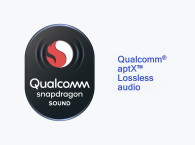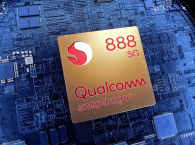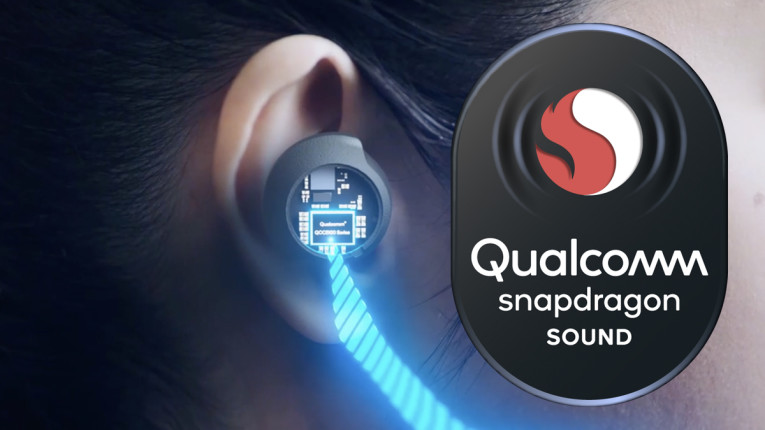
Talking about Qualcomm today, is talking about the technology that feeds today's mobile Android and Google ecosystems, a largely diverse and fragmented environment that needs to catch up to Apple's technology and platforms lead. With the latest unification effort between computing platforms, for the first time enabling Qualcomm to approach mobile and PC designs with its same family of ARM-based Snapdragon processors, the San Diego-based company sees a unique opportunity to take the lead also in audio technologies.
Qualcomm has been extremely successful in its approach to deliver the technology platforms that manufacturers and brands need for smartphones, tablets, wearables, true wireless earbuds, and with it, expand the adoption of its key underlying audio technologies which include the aptX family of codecs (now available in a more evolved combination with aptX Adaptive), combined with TrueWireless Mirroring, Active Noise Cancelation, aptX Voice and new 3D/spatial audio tools. Everything needed for a manufacturer dependent on Google's Android OS to deliver solutions that seem to compete head to head with what Apple offers - differentiated with a more complete set of features and options for developers.

The announcement of the Snapdragon Sound audio systems combines all of Qualcomm's mobile and wireless audio solutions, to foster the evolution towards hi-resolution audio transmission and 32kHz super wideband voice quality, or what Qualcomm now calls aptX Voice. This means taking all current Snapdragon mobile processors, Qualcomm's Aqstic Audio Codec and Aqstic Smart Speaker Amp, all its Bluetooth Audio QCC SoC families (QCC514x, QCC515x and QCC3056), and the before mentioned audio technologies, to enable a new generation of products that all support better quality audio.
For mobile OEMs Snapdragon Sound means access to pre-certified solutions in both devices and accessories categories, to reduce development time and shorten time-to-market. For audio brands, the system enables product differentiation from Apple, boosting the Android ecosystem as a more vertically-integrated experience. And finally, for end-users adopting Google's ecosystem, a perception of choice with verified quality and performance - something that never existed in the Android environment.
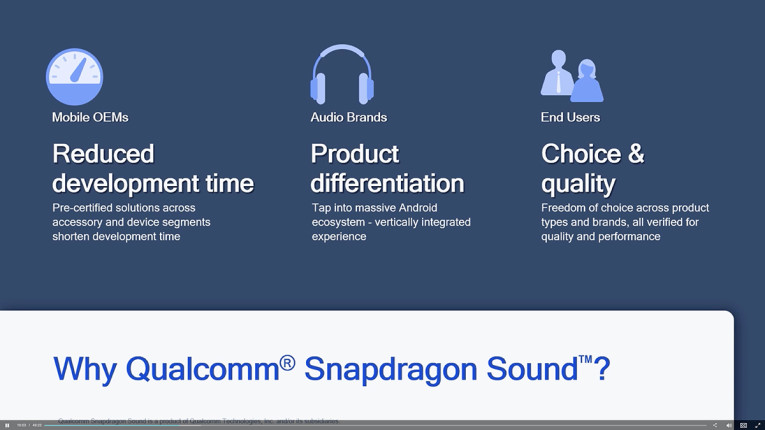
To this all encompassing strategy - and end-to-end systems approach around audio - Qualcomm calls it Snapdragon Sound, in direct reference to its family of processors. Snapdragon are Qualcomm's approach to dominate the mobile ecosystem, and potentially replace Intel processors also in computers and in consumer's minds. And this new system-level approach occurs in an environment of fast-expanding content streaming services, consumer audio product categories like hearables and smart-speakers, the unique opportunity of an accelerated migration to 5G networks, and the resulting replacement cycle. A perfect combination that Qualcomm sees as a unique opportunity to push things further using "audio quality" as a flag.
Formally, the Snapdragon Sound announcement was made by Qualcomm Technologies International, its subsidiary that includes the licensing business and patent portfolio (that includes aptX), engineering, research and development, and all products and services businesses, including semiconductors. Strategically, Snapdragon Sound is an ambitious, all encompassing strategy for Qualcomm as a whole. A great argument to gain industry support for an integrated approach with tighter control.
"The human ear is highly sensitive to glitches, latencies and other challenges which commonly occur when streaming music, video conferencing, or gaming over wireless connections. By focusing end-to-end, we are looking to deliver innovations to solve common consumer pain-points across virtually all audio interaction points,” says James Chapman, vice president and general manager, Voice, Music and Wearables, Qualcomm Technologies International.
"Qualcomm Technologies is uniquely positioned to provide tremendous value to customers with Snapdragon Sound and help them quickly commercialize products differentiated by great sound quality. Our system-level approach aggregates multiple technologies and the latest products from across our mobile and audio platform portfolios to achieve our vision of delivering high-resolution, wired quality audio, wirelessly,” Chapman adds.
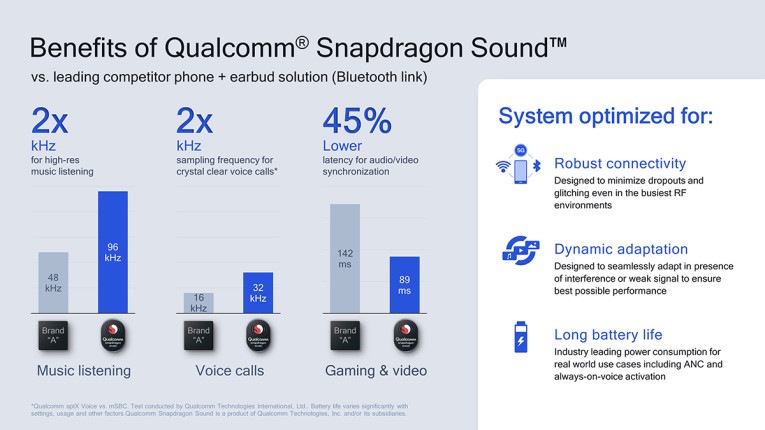
Detailing where Qualcomm Snapdragon Sound could make a difference to avoid sound quality problems, the company identified breaks in connectivity, audio dropouts and glitches, latency, and poor audio compression, as problems that it should address. "By optimizing interactions between Qualcomm technology stacks, Snapdragon Sound is designed to deliver a more robust and seamless wireless listening experience, supporting high-resolution 24-bit 96kHz audio, ultra-low latency, improved pairing, and crystal-clear voice quality. To solve end-to-end latency challenges, Snapdragon Sound can support Bluetooth latencies as low as 89 milliseconds (45% lower than a leading competitor) for more immersive gaming and a better video watching experience. For those who prefer listening directly from the mobile device, Snapdragon Sound incorporates the Qualcomm Aqstic DAC, designed to support formats of up to 384kHz 32-bit PCM and DSD with ultra-low THD+N," the company stated.
It could do all that, but Snapdragon Sound depends upon being at both ends of the equation regarding audio. For anyone reading this (and you can already read those click-bait headlines on the usual crappy tech-lifestyle websites), it would seem that Qualcomm is promising "24-bit 96kHz audio over Bluetooth!", while "audiophile" devoted blogs will be screaming that "DSD for your mobile is coming!" Well... not exactly.
The Snapdragon Sound technologies and components address all application scenarios that already exist, from streaming music services, to gaming, speakers and headphones or TWS earbuds. For each environment, and depending of the audio source, the possibilities remain constrained by existing standards and technologies. So, for example, mobile devices with a Snapdragon 8-series processor and the FastConnect 6900 mobile connectivity system will be able to leverage 5G networks to potentially receive hi-res 24-bit/96kHz audio streaming, no problem. But when transmitting those wireless over Bluetooth to headphones or to a speaker, those will need to have a QCC Bluetooth Audio SoC from Qualcomm on both sides (source and sink) to be able to support the benefits of Qualcomm aptX Adaptive, 24-bit/96kHz digital audio, 89ms latency content, or aptX Voice. And so forth. Always depending on the correct support on all sides of the ecosystem being in place.
In order to ensure high levels of performance, the Snapdragon Sound systems program for optimized devices will be tested for interoperability directly by Qualcomm Technologies. This certification will be done in a dedicated test facility in Taiwan, measuring performance including audio quality, latency, and robust connectivity. And this will need to be done for all devices, of any brand that uses the technology and platfroms. For now, Qualcomm announced early partnerships with Audio-Technica, the Japanese manufacturer, together with a Chinese smartphone maker to kickstart that program.
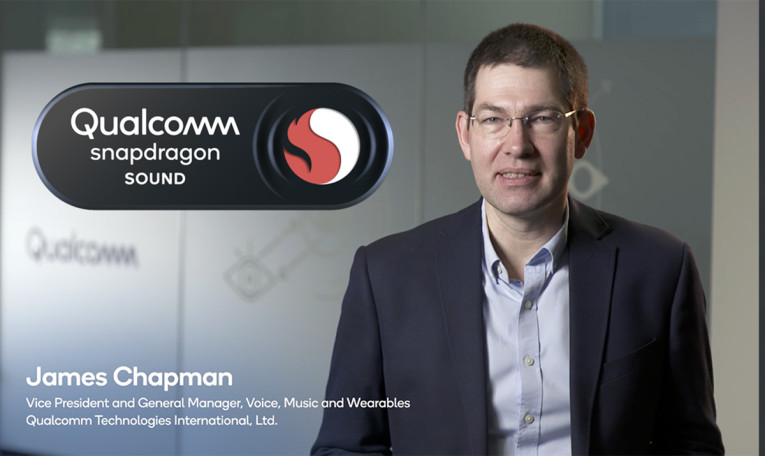
"For decades Audio-Technica has been at the forefront of the movement for premium sound. We are proud to work with Qualcomm Technologies to solve some of the challenges associated with connectivity and latency for the next generation of wireless audio, and they are uniquely positioned to help us do this. We believe that with Snapdragon Sound we get closer to our mutual vision of providing wired quality sound, wirelessly and are excited to be one of the first manufacturers to get our products to consumers,” says Kotaro Narihara, Audio-Technica's director, general manager of marketing.
Likely audio companies to make announcements in this front will probably include Bang & Olufsen, Belkin, Cambridge Audio, Cleer, Earin, Edifier, Jabra, JVC, Sennheiser, and Yamaha, all of which have been adopting Qualcomm audio technologies and SoCs in its latest wireless audio products.
With the Snapdragon Sound announcement, Qualcomm also confirmed a partnership with Amazon, and its new Amazon Music HD service, which includes lossless High-Resolution Audio support (FLAC HRA or better than CD quality), like TIDAL and QOBUZ. Amazon is promoting a special music playlist designed to "showcase the superior sound quality that Snapdragon Sound" can achieve. A smart way to boost Qualcomm's message and for Amazon to promote its music streaming efforts.
Qualcomm also says that devices supporting Snapdragon Sound can be expected to be available later in 2021. To help consumers to quickly identify compatible products, Qualcomm will promote a "Snapdragon Sound" badge to be placed on the packaging of all optimized devices, from smartphones, earbuds and headphones. In time, other devices like PCs, watches and other wearables that can deliver the full benefit of these advanced audio features will also display the Snapdragon Sound badge - a new "Intel Inside".
Qualcomm did not revealed if it intends to introduce a new aptX codec with support for higher quality lossless audio or a compressed flavor of high-resolution audio, which would always be restricted by the current bandwidth and bit-rate limitations of the Bluetooth specifications. Nevertheless, maybe there will be changes in that front in the future. As those devices will become available, we will know more about how Qualcomm intends to enable the transmission of high quality audio in more and different ways. The company just says that "further details and additional enhancements to the ecosystem" will be announced later this year.
One thing is certain, this announcement by Qualcomm, a short time after Spotify's lossless streaming upgrade announcement, will be a very strong incentive for Apple to finally confirm when it intends to unleash the high-resolution audio masters that always required from the music industry, and are stored in its music servers. In Apple's case, it already controls both the source and the sink devices to make it possible - if it wants to follow that path. But in no way that would mean that life would be easier for consumers looking for better quality audio. And meanwhile, the whole industry is working on the adoption of updated Bluetooth 5.2 and LE Audio solutions.
Qualcomm Snapdragon Sound solutions are now available to OEMs.
www.qualcomm.com/company/events/snapdragon-sound





